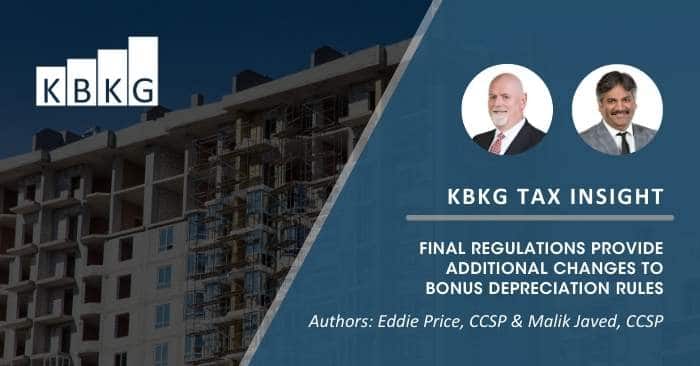On September 21, 2020, the IRS and Treasury Department finalized the last set of final regulations related to bonus depreciation. The originally proposed versions of these regulations were issued on September 24, 2019. The changes made were primarily in response to feedback submitted by tax preparers. Following are a few highlights.
Qualified Improvement Property:
On March 27, 2020, the Coronavirus Aid, Relief, and Economic Security Act (CARES Act) amended IRC section 168(e)(3)(E) to provide that qualified improvement property (“QIP”) is classified as 15-year property, thereby making it eligible for bonus depreciation, consistent with the original intent of the Tax Cuts and Jobs Act (TCJA). The CARES Act also amended the definition of QIP by providing that the improvement must be made by the taxpayer.
The Treasury Department and the IRS believe that an improvement is made by the taxpayer if the taxpayer makes, manufactures, constructs, or produces the improvement for itself or if the improvement is made, manufactured, constructed, or produced for the taxpayer by another person under a written contract. In other words, if someone buys a building where the previous owner installed QIP, the new owner does not get to depreciate those improvements as QIP.
Component Elections:
The final regulations provide that a taxpayer can make a special election to claim the 100 percent bonus rate on certain components acquired or self-constructed after September 27, 2017 that are part of larger self-constructed property where construction began before September 28, 2017. There is no longer a placed-in-service requirement for using the component election. The final regs also expanded the eligibility for larger self-constructed property to include property that is manufactured, constructed, or produced under a written contract that does not meet the definition of a “binding contract.”
The final regulations provide that the larger self-constructed property must be:
(i) MACRS property with a recovery period of 20 years or less, computer software, water utility property, or qualified improvement property, and
(ii) qualified property eligible for bonus under the 2019 final regs without regard to the acquisition date requirement.
Example:
A $10 million building is constructed that includes $3 million of section 1245 personal property and $7 million of 39-year real property. Only the 1245 property is considered part of the larger self-constructed property. The taxpayer spent $500,000 on 1245 property prior to September 28, 2017, or approximately 17 percent of the larger self-constructed property. Since this is more than 10 percent of the larger self-constructed property, the taxpayer can make the election to apply the 100 percent bonus to the $2.5 million and 30 percent bonus to the remaining $500,000.
KBKG Insight:
Non-residential real and residential rental property are not included in the larger self-constructed property when calculating the percent of costs incurred prior to September 28, 2017. In many cases, this may help the taxpayer satisfy the 10 percent safe harbor since the construction of QIP and section 1245 property tends to occur later in the construction process.
Property Previously Owned by the Taxpayer: 5 Year Rule
A property that was previously owned by the taxpayer and later purchased again can qualify for bonus depreciation if they did not have a previous depreciable interest in the previous five years. The five calendar years immediately prior to the current calendar year in which the property is placed in service by the taxpayer, and the portion of that current calendar year before the placed-in-service date of the property, are taken into account to determine if the taxpayer or a predecessor had a depreciable interest in the property prior to acquisition.
The five-year look-back period applies separately to the taxpayer and a predecessor. Furthermore, if the taxpayer or a predecessor, have not been in existence during the entire lookback period, then only the portion of the lookback period during which the taxpayer or a predecessor have been in existence is considered.
KBKG Insight:
The five-year lookback period expands the ability of taxpayers to treat used property as eligible for bonus depreciation. Additionally, it reduces a significant administrative burden that would have been required under the 2018 proposed regulations.
KBKG Case Study:
A taxpayer purchased 100 percent of a large property in 2010. On January 1, 2012, he sells 60 percent of it to an un-related partner. On July 1, 2019, he buys out the un-related partner under a 743(b) transaction and owns 100 percent of the property again. The lookback period is 2014-2018, plus January through June 2019, to determine if the taxpayer had a depreciable interest in the property. The entire section 743(b) basis increase for 60 percent of the property qualifies for bonus depreciation.
The IRS plans to issue procedural guidance for taxpayers to choose to apply the final regulations in prior tax years or to rely on the proposed regulations issued in September 2019.
Do you need help identifying qualified improvement property or taking full advantage of the component election? Contact a depreciation specialist to discuss options on how to maximize depreciation during this time of uncertainty.
Authors: Eddie Price, CCSP; Malik Javed, CCSP
Contributors: Gian Pazzia, CCSP; Lester Cook, CCSP; CJ Aberin, CCSP; Sumit Sharma, CCSP
Download KBKG Tax Insight: Final Regulations Provide Additional Changes to Bonus Depreciation Rules
About the Authors
 Eddie Price, CCSP – Director
Eddie Price, CCSP – Director
Texas
Eddie is a Director with KBKG and oversees the Southern region and its Texas-based operations. He is a Certified Cost Segregation Professional (CCSP) with the American Society of Cost Segregation Professionals. With over 35 years of cost segregation experience dating back to the Investment Tax Credit period, Eddie is one of the most experienced experts in the industry. » Full Bio
 Malik Javed, CCSP – Principal
Malik Javed, CCSP – Principal
New York
Malik Javed is a Principal and oversees engineering operations for Cost Segregation projects from KBKG’s New York practice. He is a Certified member of the American Society of Cost Segregation Professionals (ASCSP) and is currently a member of the ASCSP Technical Standards Committee. Since joining KBKG in 2004, Malik has performed thousands of Cost Segregation studies for clients in various industries and regularly reviewed architectural and engineering drawings and construction cost budgets. » Full Bio


